Wow. It’s over! I’ve completed my Pinhead internship! It flew by so quickly.
In the lab, we didn’t really do any new protocols or anything. This week, we used the micro RNA that had been isolated last week to find out if micro RNA 335 was affected in the mice that had the Mest gene knocked out. Our data revealed that micro RNA 335 expression correlated pretty well with Mest expression, and it wasn’t expressed in the Mest knockout mice (except one knockout mouse did express RNA 335. We couldn’t figure out why. We think that sample got contaminated.). To figure this out, we used a process very similar to the one we used to measure gene expression with regular RNA. There were a few key differences between the procedures, but they weren’t too drastic. It was nice that it was similar to what I had been doing before, and I felt good knowing that I had some practice, and I felt like I knew what was going on.
However, that doesn’t mean that everything necessarily went smoothly. Rob, Thomas (the other intern in the lab, a college student studying for the MCAT), and I teamed up to complete the protocol. Because of all the pipetting that we do, the bench is strewn with boxes full of disposable pipette tips. The lab goes through a lot of pipette tips because if you pipette some RNA from one test tube to another, you have to discard the tip and attach a new one before pipetting the next sample because otherwise, you’ll get RNA from the last sample into the next sample. Because we work with such small amounts of sample, a tiny amount of contamination can be a big deal, and ruin the results. Therefore, the pipette tips come in boxes that are completely sterile, and free of any enzymes that could break down RNA (these enzymes are called RN-ases, and they are all over our skin, and basically everywhere!). As part of cleaning up, I reorganized the boxes of pipette tips. In the process, I dropped one of the boxes, and all of the tips spilled everywhere, and were instantly contaminated and deemed useless. Rob angrily said that each box costs $100. I was mortified. So that happened. But then, the next day, he told me that the box I spilled cost only three or four dollars because they buy pipette tips in bulk. So that was comforting. I guess that stuff happens.
That wasn’t the end of it. The last step of the protocol involved using a multi-channel pipette (a pipette with many tips, so that you can pipette an entire row of samples all at the same time. I talked about these pipettes in a previous blog) to transfer mastermix onto the final plate that we would put our samples in. The other intern got a bubble in a few of his pipette tips, which caused him to put the wrong amount of mastermix into a few of the wells in the plate. Rob ended up being able to fix it, but it was pretty stressful. I don’t blame the intern, because those multi-channel pipettes are very difficult to use. I don’t like them! Rob was afraid that those samples wouldn’t work, but they turned out just fine.
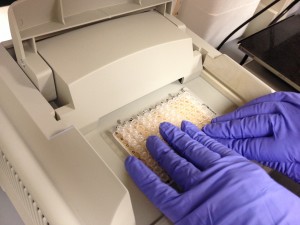
This is a picture of the Assay Plate, with a tiny bit of sample in each well, being put into the PCR machine.
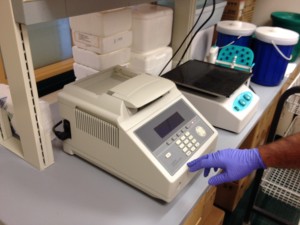
This is a picture of the PCR machine more zoomed out. The lid is closed, so you can’t see the Assay Plate inside.
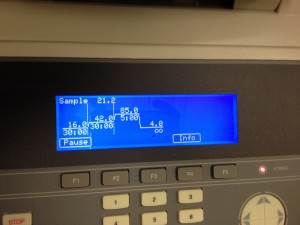
This is what’s on the screen of the PCR. It shows the different temperatures that it will cycle through. Basically, it shows how long it will hold each temperature in order to make sure that the denaturing, annealing, and extension phases take place (I explained this in more detail in a previous post).
We had some hiccups along the way, but eventually we got our data and everything worked out, except for the one mouse showed Mest expression even though it was a Mest knockout. That was weird, and we couldn’t figure it out. But we did it!
Rob had been using a machine called an NMR (Nuclear Magnetic Resonance) to measure fat mass, lean mass, and fluid mass in his mice. That way, he could tell if the mice were, in fact, gaining fat mass, and not muscle or fluid, when they got heavier. However, it was making inconsistent, inaccurate measurements, so he had to send it to Germany to get it fixed. He just got it back, and now he’s testing it out to make sure it’s working properly before he starts using it for his experiments again. To do this, he created an “artificial mouse” and he puts it in the NMR every day, and records the results. He then looks at the results to make sure that they are consistent from day to day. He made the artificial mouse by filling a plastic baggie with sesame seeds, vacuum grease, and a bit of water. The sesame seeds account for the fat mass, the vacuum grease is measured as protein (lean mass), and the water, of course, is fluid. Because it’s not living, the fat, lean, and fluid masses of the artificial mouse won’t change, so he can easily use it to make sure his NMR is making consistent measurements! I thought it was clever how he made his artificial mouse. Thomas and I helped Rob create graphs to analyze this data, and we concluded that the NMR is working normally again. Yay!
Last week, I told you how we finished the Bmp3 experiment, but Rob didn’t have time to show me the results. This week, he got around to showing me the results, and it was really interesting! We got results that were very different from the previous experiment, which was perplexing. The 21-day old mice expressed Bmp3 in their livers very differently in the experiment that Rob and I did compared to the one that Rob did a few years ago. Rob has a very clever theory as to why this happened. He thinks that in one of the experiments, the 21-day old mice had been weaned from their mothers, while in the other experiment, they had not yet been weaned. Mother’s milk is very different from the chow diet that the mice are fed after they are weaned, and Rob thinks that this could have contributed greatly to the differences that we saw in the 21-day old mice in the first experiment compared to the second. He said that next, he’s going to repeat the experiment, this time with the goal of figuring out if weaning has anything to do with Bmp3 expression in 21 day old mice.
On the last day, Rob let Thomas and I work together unsupervised to quantify RNA from the Bmp3 experiment using the Qubit. I explained the Qubit in another post. It was cool that even though we were interns, by our last day we were able to do the Qubit on our own! We even did the calculations by ourselves afterwards. It really showed me how far I have come. It’s crazy to think that six weeks ago, I didn’t even know what a pipette was, and that now I have worked up to the point that I can help with a protocol completely unsupervised! Our results turned out just like they were supposed to, and I’m really proud of it.
I’m going to miss the Cross Country girls terribly. Today, a bunch of them are doing a 10k race called the Beach to Beacon, and I’m so jealous of them! It’s a huge race with thousands of people, and there is only a five-minute window to sign up online before it fills up. If I had known about it, I would have signed up because it would have been an excellent way to finish off my time in Maine with a fun race with my new friends. Oh well. I guess I shall sit inside and do summer homework and try to motivate myself to write essays for college applications instead. I hope they all do well and run fast. One of the girls posted a picture showing that she met Shalane Flannagan there, who is super fast. I’m jealous. It was so much fun to have a wonderful group of girls to hang out with. I credit my dad for setting me up with them because he was the one who contacted the XC coach, so thank you so much Daddy! You made all the difference, that was genius!
On Thursday, I attended the weekly lectures, as usual. One of the lectures was given by an orthopedic surgeon who also performs research. He even had some experience with biochemistry research. He talked to us about the physics of the human gait, and even showed us a picture of an x-ray where he had drawn a bunch of lever arms and labeled a bunch of angles on the x-ray image in order to do calculations regarding how to fix one of his patient’s hip joints so that they could walk without a limp. I was really interested in the physics behind it all. This information would then help him decide how to put in hip replacements, which brought in an aspect of biomedical engineering, which was interesting. He also explained to us why he chose to focus on clinical research instead of lab research. He said that when you’re back in the lab, you’re so far removed from the problem that you’re actually trying to solve, so it’s really easy to forget about the big picture when you’re monotonously loading samples into test tubes. But when you’re doing clinical research, you’re working more directly with the patients, enabling you to see the implications of your research more clearly, so you never forget that you’re making a difference. That was a really interesting thought to me, because I could relate to what he was talking about regarding lab research. It makes me want to give clinical research a try! One of his clinical research projects was particularly interesting to me. He explained that as an orthopedic surgeon, he has a checklist of non-surgical remedies to try before he puts his patients under the knife, including weight loss, exercise, or walking with a cane. He collected data to reveal that a disturbingly small percentage of patients actually try any of these, and instead readily undergo surgery as if it’s their only solution. He wants to develop methods to ensure that surgery is a last resort. I’m curious as to what methods he’ll come up with.
Also, two medical school students each gave a lecture, presenting the research that they did in their internships. Both of them gave excellent presentations, and were extremely smart. This really put it into perspective how smart medical students are, and it also made me realize that I need to up my game with my public speaking skills!
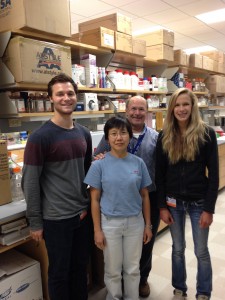
The Lab Group! From left to right: Thomas, Rea, Rob, Me. David was not at the lab on my last day, so unfortunately, he’s not in the picture.

This is me with my host family. From left to right: Scott, Rebecca, Me, Emma. Scott is holding their dog Zoe, and Emma is holding Buddy.
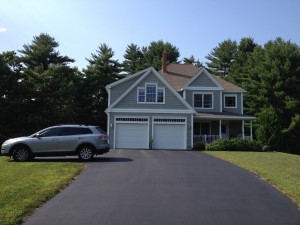
This is the house I stayed in all summer with my host family. Also, out front is the car that they so kindly let me borrow.
Through this internship, I’ve learned so much. More importantly, I’ve gained an experience that has taught me more than school ever could. I realized that we are coming up with results that no one has ever seen before. I have literally helped make new scientific findings. As interesting as science class is in school, we simply do labs so that we can see something in action that has already been proven. But at the Koza lab, it’s the real deal because we’re exploring the realm of the unknown. It’s so exciting to think of it that way. To experience real research as a high school student is incredibly special, and I’m so thankful to the Pinhead Institute for choosing to give this valuable opportunity to me.

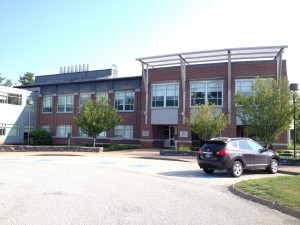
Sabine, congratulations! You are a hot-shot. You know how to make a momma proud. I am fascinated by the lab research/clinical research comparison. Also, I’m interested to hear more about your thoughts on the biomedical aspect of the presentation you attended on Thursday by the orthopedic surgeon. I’m so grateful to your host family, to Rob and Rea, and to the Pinhead Institute for this amazing experience you have had. Love you, girl!
PS, the photos are perfect! Thank you!
Once again, you amaze me!! Sabine, I’m so glad you were chosen for this program. I have enjoyed reading your blogs & learning along with you. Now on to Harvard Medical School. Have another wonderful journey. Love you so much!
Sabine, I can’t believe the internship is done. I have enjoyed your blog updates and talking to you hearing your genuine excitement in the experience. Many thanks to Rob, Rea, Rebecca, Scott, Emma and tomorrow Ken Gray for transportation to Harvard. You Rock!! I love you so much and thanks for the kudos in this blog, you clearly made the most of your experience. Can’t wait to hug you tight in couple of weeks.
Sabine, Thanks for keeping us informed about your work, your host family, and outside activities. Must have been a great experience. Missed seeing you and Gretchen this summer,
but had a nice visit with Bill and CW. Best wishes in all of your future endeavors.
Love, Brad
Woohoo! You finished! I love reading about your time at the lab, and the lecture by the surgeon/ researcher. I think the critical research sounds exciting, and such an important aspect of how we view our health in this country. It certainly seems like most people don’t want to try and heal themselves and will just go get surgery. (PS you totally got game girl and you are going kick booty in med school) I love and miss you and hope you have a great time at Harvard!